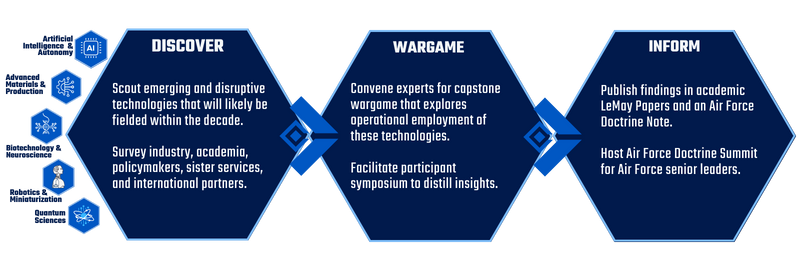Air Force Doctrine 2035 - at the Intersection of Technology and Doctrine.
Airpower was born out of technological disruption. Throughout history, militaries that effectively integrated new technologies had an upper hand over their rivals. Conversely, those that held onto old thinking and outmoded strategies failed on the battlefield. As airpower theorist Giulio Douhet said, “victory smiles upon those who anticipate the changes in the character of war, not upon those who wait to adapt themselves after the changes occur.” The message is clear: in the coming decade, technological advances will accelerate changes to the character of war.
To anticipate rather than retroactively adapt, Air Force Doctrine 2035 (AFD35), an initiative of the LeMay Center for Doctrine Development and Education, is beginning a yearlong endeavor to explore disruptive technologies and assess their doctrinal implications. AFD35’s goal is to prevent future doctrinal surprises, avoid doctrinal stagnation, and catalyze doctrinal evolution to match the accelerated pace of technological change.
This effort will scout five critical focus areas:
Artificial intelligence and automation are not only optimizing mission execution and decision support but are also forcing a reassessment of foundational warfighting constructs, particularly the tempo of operations and the role of human oversight within command-and-control hierarchies. Furthermore, the Air Force stands on the cusp of a new era defined by human-machine teaming. The nascent deployment of AI, autonomy, and uncrewed collaborative aircraft is already reshaping Airmen’s relationships with technology.
Developments in advanced materials and production methods, including additive manufacturing and high-performance composites, are dissolving the traditional constraints of logistics and sustainment, enabling more agile and resilient basing concepts. Meanwhile, biotechnology and neuroscience are redefining the human element of warfare, elevating the importance of Airman performance, neuro-adaptive systems, and biosensing in the context of multi-domain command and control.
Quantum sciences portend a revolution in navigation and computation that will challenge assumptions about security, precision, and resilience, introducing both game-changing potential and significant operational risk. Simultaneously, robotics and miniaturization are reshaping the scale and signature of conflict, altering maneuver, targeting, and deterrence strategies in an increasingly automated battlespace.
As our adversaries weaponize disruptive technologies at blistering speed, AFD35 will ensure the Air Force stays agile, lethal, and doctrinally grounded by leveraging the unique capabilities of the LeMay Center. Our team of experts from Air Force Lessons Learned, Air Force Doctrine Development, and the Air Force Wargaming Institute will convene warfighters, technologists, and strategists to discover, wargame, and inform Air Force doctrine at the speed of relevancy. After cataloguing information from across the focus areas, a capstone wargame and symposium will distill insights to be published in academic papers and an Air Force Doctrine Note. The project will culminate in senior leader discussion at an Air Force Doctrine Summit.

Building on I.B. Holley’s 2004 book, Technology and Military Doctrine: Essays on a Challenging Relationship, AFD35 aims to redefine the relationship between technology and doctrine through targeted questions:
- Will new technologies…
- Privilege the offensive or defensive?
- Negate or enhance airpower’s inherent advantages?
- Drive centralization or decentralization of C2?
- Enable greater or less awareness of adversary actions and intentions?
- Bypass conventional defenses?
- Alter Airmen’s relationship with the Joint Force?
- Will the introduction of agentic warfare operations drive changes to planning and revolutionize airpower?
- How will quantum-enabled communications negate ISR?
- Will human-machine, localized decision-making reset command relationships?
- What combination or integration of technologies will introduce strategic advantage?
- Does miniaturization negate current concepts for air defense?
- How will proliferated autonomous drones alter concepts of air superiority and airspace control?
- Will biotechnologies introduce new strategic attack vectors and alter strategic deterrence calculations?
- What does precision mass mean for airpower doctrine?
- How will machines speed kill webs and alter C2?
Ultimately, the rapid acceleration of disruptive technologies demands a proactive, rather than reactive, approach to Air Force doctrine. As our namesake, Gen Curtis E. LeMay aptly stated, "at the very heart of warfare lies doctrine." AFD35 will ensure that doctrine harnesses emerging technologies so the Air Force of 2035 is prepared for changing character of war.
If you have insights, platforms, technology, or just want to share your thoughts about AFD35, please reach out to us at usafdoctrine@us.af.mil. We look forward to Advancing Airpower together!